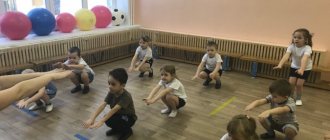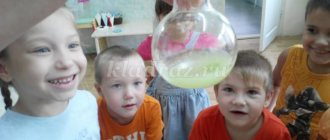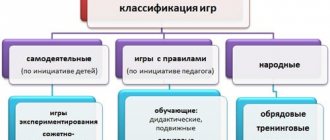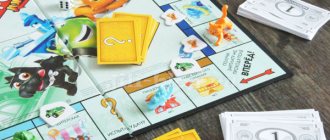Analysis of the research results using the method of E.G. Rechitskaya and E.A. Somina
The results of the study using the methodology developed by E.G. Rechitskaya and E.A. Somina based on the “Incomplete Figures” test by E. Torrance.
Children are shown pictures of simple geometric shapes (circle, square and triangle) on separate blanks. Based on each of the proposed figures, the child is invited to make as many drawings as possible, and, in addition, the drawing can be made both inside and outside the contour, turning the sheet convenient for the child and depicting the figure, that is, each figure can be used at different angles.
The quality of the drawings in terms of their artistry, proportions, etc. is not considered in the analysis, since the interest is primarily in the idea of the composition itself, the variety of associations that arise, the principles of implementing ideas, and not the technical execution of the drawings.
The working time is not limited, otherwise the child will look anxious and insecure, which contradicts the essence of the creative process, which should be simulated during the experiment.
This technique activates the imagination and reveals one of its fundamental properties - to see the whole before the parts. The child perceives the proposed test figures as parts of a whole and completes and reconstructs them. The possibility of realizing such a reconstructive function of the imagination lies in the specificity of this mental process. The mechanism of imagination is always based on the processes of dissociation and association, analysis and synthesis of existing ideas. A child who arranges figures into object images performs a synthesis operation. However, this is only possible through a preliminary analysis of a given figure, isolating it from a variety of objects, identifying its properties, studying its functional characteristics, etc. The degree of formation of the operations of analysis and synthesis largely determines the productivity of imaginative activity.
Candidates of Psychological Sciences, Professor E.G. Rechitskaya and E.A. Soshin developed six quality levels into which the entire set of children's drawings can be distributed:
Level 1 - the work is characterized by extreme schematics, an almost complete absence of details. Children depict individual objects, the contours of which, as a rule, coincide with the contours of the proposed geometric shapes.
Stage 2 is characterized by a less schematic image, the appearance of a large number of details both inside and outside the main contour.
Level 3 is characterized by the appearance of a “field of things” around the base image, i.e. objective design of the environment (for example, a trapezoid is no longer just a plate, but a vase standing on a table, or a circle is not just an apple, but on a plate). At this level, a change in the scale of the image also occurs due to the use of a specific test figure as a large part of the whole image (for example, a circle is no longer a ball or a balloon, but the head of a person or animal, a car wheel; a square is not a mirror or a cabinet, but robot body, truck body, etc.). At the same time, the geometric figure as a section of the picture continues to occupy a central position in the picture.
Stage 4 - the work is characterized by a broad thematic environment. Having transformed the test figure into any object, children add new elements to the drawing and organize the entire composition in accordance with the invented plot.
Stage 5 - the works are characterized by the repeated use of a given figure in the construction of a single semantic composition. Test figures in such compositions are given a familiar camouflage by reducing their scale, changing their spatial position and complicating the composition. The possibility of reusing a test figure as an external stimulus when forming an imaginative image indicates the plasticity of the imagination and a higher level of formation of its operational components.







